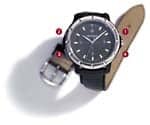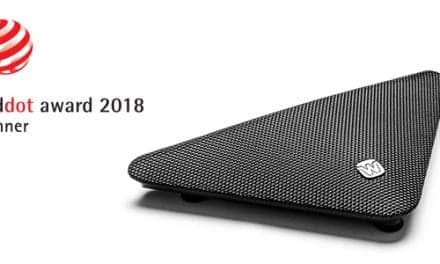
A new device called the remote control WatchPilot will soon become available as an option with the Phonak Claro hearing system. The product is the first hearing instrument remote control to be housed within a fully functional quartz watch.
Development and Function
The WatchPilot has been developed to utilize a miniature transmission system with sufficient power to control hearing instrument functions while being small enough to fit within the case of a standard-size watch. The orientation of the transmitter inside the watch and new chip technology allow a significant reduction in size and power requirements.
A binary coding system is designed to ensure an effective transmission protocol for reliable instrument response. The receiver in the Claro hearing system is designed to increase sensitivity and improve transmission efficiency, extending the practical operating distance to 60 cm (about 2 ft.). This means that the natural position for reading the watch is also the ideal position to use the remote control function.
Four function keys are featured on the remote/watch to select the desired programs (or activate the Auto Select function), and/or manipulate the volume control and FM functions in Claro FM instruments (FM and FM+M). A small light (LED) on the watch provides visual confirmation whenever a button is pressed, and the hearing instrument functions can be manipulated binaurally.
Two small batteries power the system: one for the remote function and one for the watch. These have an expected battery life of three years and can be changed by a hearing care professional or a watch shop. Many remote controls require up to three AAA batteries and consume 80 mA of power for every press of a button with 100 ms duration. In the new remote/watch, battery consumption has been reduced to 21 mA of current for the same transmission time. For comparison purposes, this is equal to 1/16,500,000 of the current consumed by a 100 watt light bulb.
There are two styles for the watch: “Classic” and the smaller “Elegance” with a white or black watch face and a choice of bands. The dial is protected under a scratch-resistant mineral glass to ensure that reading the time is accurate, even in poor light. The device is waterproof to 30 meters.
Preliminary Field Trial
During May 2000, eight hearing instrument users took part in a preliminary field study to evaluate the use of the remote control WatchPilot using fully functional prototypes. Participants had an average age of 64 (range 39-80), and the goal was to gauge general views on efficiency, functionality and acceptance using questionnaires administered after the product had been used in “real-life.” The subjects, half of whom had previous experience with hearing instrument remotes, reported that they liked the combination wristwatch and remote control, describing it as “very useful” and “practical.” They found the “easy to understand” utility helpful and reported no difficulty remembering which button to press for each function. The subjects said the remote was convenient and provided fast and reliable control of the hearing instrument(s).
Summary
The responses from the field trial confirm that the remote control WatchPilot offers a high-tech solution for convenience and user-control. Choosing the appropriate hearing program for the environment or activating the AutoSelect function are reportedly made easy with the device.
This article was submitted by Steffi Kalis of the Audiological Communication & Education Dept., Phonak AG, Staefa, Switzerland. Correspondence can be addressed to HR or Steffi Kalis, Phonak AG, LaubisruetiStrasse 28, CH-8712 Staefa, Switzerland; email: [email protected].
Reference
1. Kochkin S: Customer satisfaction & subjective benefit with high performance hearing aids. Hearing Review 1996; 3 (12): 16-26.
2. Schuchman G, Valente M, Beck LB & Potts L: User satisfaction with an ITE directional hearing instrument. Hearing Review 1999; 6 (7): 12-22.
3. Kochkin S: MarkeTrak V: Consumer satisfaction revisited. Hear Jour 2000; 53 (1): 38-55.



